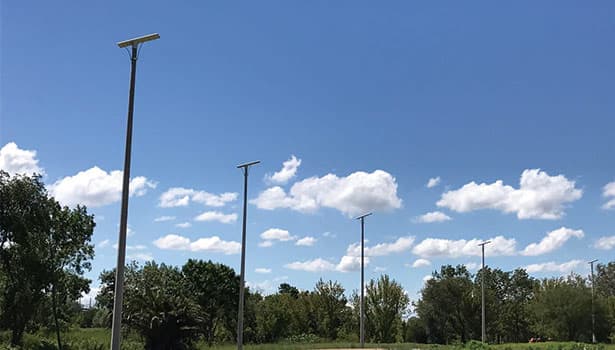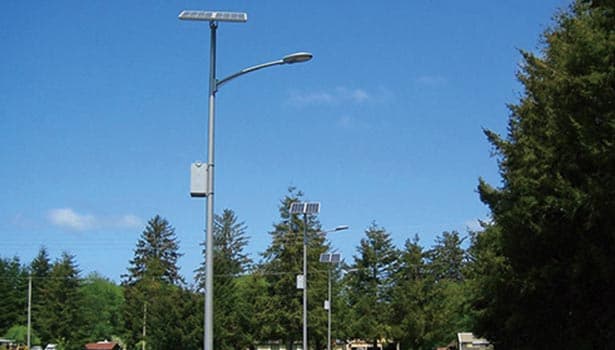How to Check Your Solar Panels Are Charging Your Batteries
In the operation of solar street lights, the core issue is whether the solar panels can charge the battery normally. Once there is an abnormality in charging, it will not only affect the normal use of the device, but also may cause a chain of faults.
In addition, timely checking of the charging status can prevent the battery from having its lifespan shortened due to long-term undercharging, and can also detect potential problems with components such as solar panels and controllers in advance, reducing later maintenance costs. It can be said that regularly checking the charging status of solar panels for batteries is a key link to ensure the stable and efficient operation of solar street lights.

5 Ways to Check Your Solar Panels Are Charging Your Batteries
Check the Solar Charging Controller
The solar charging controller serves as a "bridge" connecting the solar panel and the battery. Its built-in indicator lights or display screens can directly reflect the charging status and are the easiest way to operate for inspection.
At present, the solar charging controllers available on the market are mainly divided into two categories: "indicator light type" and "digital display screen type".
- Indicator light type: Most controllers use LED lights of different colors to indicate status. A common rule is that if the green light remains constantly on or flashes, it indicates that the solar panel is charging the battery. A constantly lit blue light often indicates that the battery is fully charged. When the red light is on, it may indicate a fault (such as abnormal wiring or over-discharge of the battery). Please note that the light color definitions of controllers from different brands may vary. It is recommended to check the product manual in advance for confirmation.
- Digital display model: This type of controller will directly display data such as "charging current", "battery voltage", and "charging mode". If the screen shows "Charging", "CC" (constant current charging) or "CV" (constant voltage charging), and the current value is positive (usually between 0.5A and 10A, depending on the system power), it indicates that the charging is normal.
Use the Battery Monitoring System
For mid-to-high-end solar street light systems, a battery monitoring system is usually equipped, which can provide you with more accurate charging data and is suitable for scenarios that require refined management.
How to check the charging status through the monitoring system?
Battery voltage: In the charging state, the voltage should be higher than the battery's "float voltage" (for example, the float voltage of a 12V lead-acid battery is approximately 13.8V, and that of a 24V lithium battery is about 27.6V), and it should increase slowly with the charging time.
Charging current: Under normal circumstances, the current should be positive (indicating that the solar panel is transmitting power to the battery), and the value should match the power of the solar panel (for example, a 100W solar panel with a 12V battery, the charging current is approximately 8A).
Charging progress (SOC) : This refers to the remaining battery power. If the SOC value rises slowly on a sunny day (for example, from 50% to 60%), it indicates that the charging is normal.
How to determine if the data meets expectations?
After obtaining the data, it needs to be compared with the value of the "normal charging cycle"
- On a sunny noon (11:00-15:00) : At this time, the sunlight is the strongest. The charging current should reach the maximum value of the day, and the voltage should be close to the battery's "equalizing voltage" (for example, the equalizing voltage of a 12V lead-acid battery is approximately 14.4V).
On cloudy days or in the early morning: The charging current will decrease (possibly to 1-3A), and the voltage will be slightly higher than the float charging voltage, which is a normal phenomenon.
If the data deviates significantly from the above expectations (for example, the current at noon is only 0.5A), further investigation into other issues is required.
Use A Multimeter to Test
A multimeter is a commonly used tool by electricians. It can determine whether a solar panel is charging by measuring the changes in battery voltage. This method does not rely on the built-in equipment of the system and is suitable for all types of solar street light systems, especially for old systems (without controller display screens or monitoring systems).
Prepare tools and safety precautions
- Tools: Prepare a digital multimeter, insulating gloves (to avoid electric shock), and a small wrench (for disassembling terminal blocks).
- Safety Tip: Before operation, make sure the solar panel is in a "no strong light" environment (such as on a cloudy day or when the solar panel is blocked) to avoid generating a large current when disassembling and wiring. If the system voltage exceeds 36V, insulating gloves must be worn to prevent electric shock.
3 steps to complete the detection
Disconnect and measure the "initial voltage"
Turn off the main switch of the solar lighting system, loosen the terminal between the battery and the controller with a wrench, and set the multimeter to the "DC voltage range" (select a range slightly higher than the battery voltage, such as 20V for a 12V battery and 50V for a 24V battery).
Connect the red probe of the multimeter to the positive terminal (" + ") of the battery and the black probe to the negative terminal (" - "). Record the voltage value at this time (i.e., the "initial voltage", for example, a 12V battery may be 12.5V after discharge).
Reconnect to charge the solar panel
Reconnect the battery to the controller (make sure the wiring is firm and not loose), remove any obstructions from the solar panel, and let the solar panel charge in the sun for 20 minutes to 1 hour (the charging time should be adjusted according to the intensity of the light: 20 minutes at noon on a sunny day and 1 hour on a cloudy day).
Measure again and compare the voltage changes
After charging is complete, measure the battery voltage again according to the method in the first step. If the second voltage is higher than the initial voltage (for example, from 12.5V to 13.2V), it indicates that the solar panel is charging the battery. If the voltage remains unchanged or drops, there is a fault in the charging.
Check the Inverter
The core function of an inverter is to convert the direct current from the battery into alternating current (for use in household appliances, street lights and other devices), but some inverters will simultaneously display the charging-related data of the battery, which can be used as an indirect inspection basis.
What are the "charging signals" on an inverter?
- Display data: Most inverters will display "Battery voltage" and "Input power". If the "input power" value is positive and the battery voltage rises slowly over time, it indicates that the solar panel is charging.
- Status indicator light: Some simple inverters will use a "charging indicator" light to prompt - a flashing green light indicates that charging is in progress, while a red light may indicate a charging fault (such as insufficient input power of the solar panel).
"Limitations" of inverter data
It should be noted that the inverter displays the "overall system status" rather than direct charging details. For instance, if the inverter shows "Normal battery voltage", there might be a problem of "too small charging current for the solar panel". Therefore, inverter inspection is more suitable as an "auxiliary means", and a comprehensive judgment should be made in combination with the detection results of the controller or multimeter.
Visual Inspection and Environmental Factor Investigation
Sometimes, when solar panels fail to charge properly, it is not due to component failure but rather external environmental issues or wiring problems. Through visual inspection, such "easily solvable" problems can be quickly eliminated.
Check the lighting conditions of the solar panels
Solar panels generate electricity by relying on light. If there is insufficient light, even if there are no faults in the components, the battery cannot be charged. The key points for inspection include:
- Whether there are any obstructions: Check if the surface of the solar panel is covered with leaves, dust or bird droppings. Are there any newly planted trees or newly-built buildings around the solar street lights that block the sunlight (especially during the strong light period from 9 a.m. to 3 p.m.).
- Whether the installation Angle is reasonable: The optimal installation Angle for solar panels in the Northern Hemisphere is usually "local latitude + 10°". A large Angle deviation will reduce the power generation. If the Angle of the solar panel of the solar street lightis found to be abnormal, the bracket should be adjusted in time.
Check the integrity of the line connection
Loose, corroded or damaged circuits can prevent the current generated by the solar panels from being transmitted to the battery. The following parts need to be inspected with emphasis:
- Wiring between the solar panel and the controller: Check if the joints are loose; Is there any oxidation or corrosion at the joint?
- Battery terminal blocks: Check whether the positive and negative terminals of the battery are firmly connected and if there is any leakage.
- Check if the wires are damaged: Inspect whether the outer sheath of the wires has been bitten by rats or scratched by branches. If there is any damage, wrap it with insulating tape or replace it with a new one.

6 Reasons Why Solar Panels Cannot Charge Batteries
Insufficient lighting
Sunlight is the foundation for solar panels to generate electricity. If there is insufficient sunlight, the power generation will drop significantly and may even fail to meet the battery charging requirements.
Common scenarios include
The installation location is not good
Installing solar street lights in areas with weak light (such as balconies or under eaves) instead of in unobstructed places (such as rooftops or open Spaces) will cut off direct sunlight.
Seasonal and weather changes
In winter, the days are shorter and the sunlight is weaker, which usually leads to incomplete battery charging. More than three consecutive days of overcast and rainy weather can also cause the battery of solar street lights to fail to be fully charged.
The surface of the solar panel is dirty
Over time, the dust, oil stains or bird droppings accumulated on solar panels will form a "blackout layer". This shading layer will reduce the amount of sunlight reaching the solar panels, thereby lowering the power generation.
How to solve the problem of insufficient sunlight
Clean the surface of the solar panels
Rinse the battery panels with clean water to remove dust, bird droppings or loose debris. Avoid using hard-bristled brushes - they can scratch the glass of the solar panels (thus affecting light absorption). For oil stains, you can choose to use a mild cleaner, gently wipe with a soft cloth, and then thoroughly rinse with water.
Remove or bypass obstacles
Trim the overhanging branches that block the solar panels. If the building's obstructions cannot be removed, reposition the solar panels (for example, move the roof panels to a south-facing, unobstructed area - this is an ideal location for sunlight in the Northern Hemisphere).
Adjust the Angle of the solar panel
Set the Angle of the solar panels according to your local latitude: In the Northern Hemisphere: Tilt the solar panels slightly higher in winter and slightly lower in summer. This can ensure that sunlight shines vertically onto the solar panels at noon (the time of the day when the sun is strongest), thereby maximizing the energy capture rate.
Connection Failure
The circuit is the "channel" for current transmission. If the channel is interrupted or blocked, the current cannot reach the battery from the solar panel.
Common questions include:
- Loose wiring: The terminal blocks were not tightened during installation, or the joints became loose due to vibration after long-term use. For instance, the wiring of solar street lights gradually became loose due to the vibration caused by vehicle passage.
- Wiring corrosion: In damp and rainy environments, the wiring terminals are prone to oxidation and corrosion, forming a "resistance layer" that hinders current transmission. In coastal areas, due to the high salt content in the air, the wiring corrosion problem of solar street lights is more severe.
- Wiring error: Some users, when installing by themselves, reversed the positive and negative terminals of the solar panels, causing the controller's protection function to activate and cutting off the charging circuit.
How to solve Connection failure problem?
- Tighten loose wiring: Use a wrench or screwdriver to tighten all terminal blocks (be careful with the force to avoid breaking the screws), especially the joints between the solar panel and the controller, as well as between the battery and the controller.
- Dealing with corroded joints: Gently sand the oxide layer at the joint with sandpaper until a metallic luster is exposed; Then apply a small amount of Vaseline to the joint to prevent further corrosion.
- Correct wiring errors: Refer to the system manual to confirm the positive and negative terminal wiring sequence of the solar panel, controller, and battery (usually "solar panel → controller → battery"). If they are connected in reverse, power off and rewire.
Component Damage
Solar panels, charging controllers and batteries are the three core components of the system. Any damage to any of these components will lead to charging failure.
- Solar panel damage: The glass may break or the solar cells may be cracked due to hail impact. Or due to long-term exposure to the sun, the back plate ages and water enters the junction box, causing a sudden drop in power generation.
- Controller failure: If the internal chip of the controller burns out (such as due to lightning strike or excessively high voltage), it will lose the function of "regulating charging current" and be unable to transfer the current from the solar panel to the battery.
- Battery damage: Long-term undercharging of lead-acid batteries can lead to "sulfation" (white lead sulfate crystals form on the electrode surface, making it impossible to store electricity). Excessive charging and discharging of lithium batteries can cause the battery cells to bulge and lose their power storage capacity.
If it is confirmed that the component is damaged, "Repair" or "replace" should be selected according to the extent of the damage:
- Solar panel damage: If only the glass is broken (the solar cells are not damaged), the glass can be replaced. If the solar cells break or water gets into the junction box, new solar panels need to be replaced (it is recommended to choose monocrystalline solar panels with a conversion efficiency of ≥20%, which are more durable).
- Controller failure: Damaged controllers are usually irreparable and need to be replaced with controllers of the same model and power (pay attention to voltage matching when replacing, for example, a 12V controller should be selected for a 12V system).
- Battery damage: If a lead-acid battery shows sulfation (voltage lower than 10.5V), you can try activating it with a "Repair charger". If the activation is ineffective or the lithium battery is swollen, a new battery should be replaced directly (select a model that matches the system voltage and capacity, for example, a 12V/100Ah battery for a 12V system).
Improper Configuration
The components of solar street lights need to be "matched" to function properly. If they are improperly configured, even if all the components are functioning normally, they cannot be charged effectively.
Common questions include:
- Power mismatch: The power of the solar panels is too small to meet the battery charging requirements; Or the controller power is too small to withstand the maximum current of the solar panel.
- Voltage incompatibility: The output voltage of the solar panel does not match the battery voltage. Charging a 12V battery with a 24V solar panel will cause overcharging of the battery. Charging a 24V battery with a 12V solar panel cannot reach the charging voltage threshold.
"Replacing components" or "adjusting the load"
- Power mismatch: If the power of the solar panel is too small, a solar panel with a higher power needs to be replaced. If the power of the controller is too small, a controller with a higher rated current needs to be replaced.
- Voltage incompatibility: If the voltage of the solar panel does not match that of the battery, the component with the corresponding voltage needs to be replaced.
- Load overload: Reduce the number of loads connected to the battery, such as removing redundant monitoring devices from solar street lights or replacing them with higher-power controllers.

Overload or Overcharge Protection
To protect the battery and the system, the controller will set up "overload protection" and "overcharge protection" functions. If these mechanisms are triggered, the charging circuit will be temporarily cut off.
- Overload protection: If the battery is connected to too many loads, such as a solar street lightbeing simultaneously connected to LED lights, surveillance cameras, and charging piles, and the total power exceeds the rated load power of the controller, the controller will cut off the charging and prioritize the power supply to the loads.
- Overcharge protection: Once the battery is fully charged, the controller will automatically stop charging to prevent battery damage due to overcharging. At this point, it may seem like a "charging interruption", but in fact, it is a normal protection mechanism. Once the battery power is exhausted, it will automatically resume charging.
This type of problem does not require component replacement; it only needs to adjust the system status.
- Overload protection: Turn off some non-essential loads (such as temporarily turning off the advertising screen of the solar street light), and gradually start the load after the battery is fully charged. If it is overloaded for a long time, the controller power needs to be upgraded or the battery capacity increased.
- Overcharge protection: No operation required. This is a normal protection mechanism. When the battery voltage drops due to load consumption, the controller will automatically resume charging (usually when the voltage drops below the float charging voltage).
Battery Health Issues
The battery is a "container" for storing electrical energy. If the container itself is damaged, even if the solar panel is generating electricity normally, it cannot store electricity.
Common battery health issues include:
- Expiration of lifespan: The normal lifespan of lead-acid batteries is approximately 3 to 5 years, while that of lithium batteries is about 5 to 8 years. After exceeding their lifespan, the "capacity" of the batteries will drop significantly, and they will be unable to store sufficient electricity for the normal operation of solar street lights.
- Long-term undercharge: If solar street lights remain in a state of "discharging more than charging" for a long time, the battery will be in a state of undercharge for a long time, accelerating aging and eventually being unable to store electricity.
- Battery bulging (lithium battery) : If a lithium battery is overcharged, overdischarged for a long time, or exposed to a high-temperature environment, the battery cells will bulge. At this point, the battery can no longer function properly and needs to be replaced immediately; otherwise, it may cause safety hazards.
Precautions for replacing solar street light batteries
- Select the matching model: Ensure that the voltage and capacity of the new battery are consistent with those of the original solar street lightbattery.
- Correct installation: When installing, be careful not to reverse the positive and negative poles. For lead-acid batteries, it is necessary to ensure that the safety valve is not damaged. For lithium batteries, avoid squeezing and collision.
- Initialization charging: After the new battery is installed, the solar panel needs to be continuously charged for 24 hours on a sunny day to complete the "activation" and ensure that the battery reaches the best power storage state.
The charging state of the battery by the solar panel directly determines the operational effect of the solar street light. As long as you do a good job in "inspection + maintenance + correct operation", solar street lights can operate stably for a long time and provide you with continuous and clean energy.




